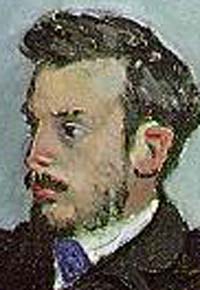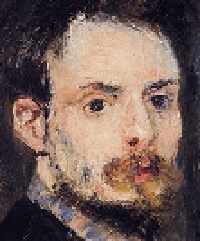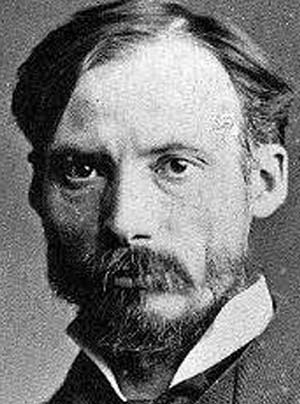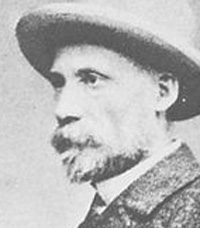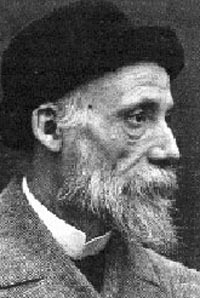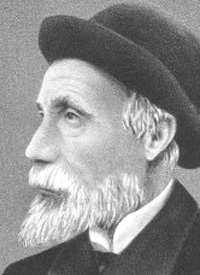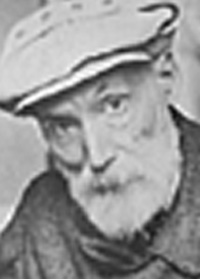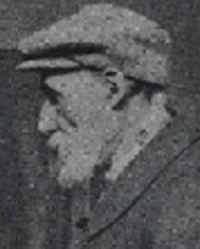Pierre Auguste Renoir
Copyright Michael D. Robbins 2005
Astro-Rayological Interpretation & Charts
Quotes
Biography
Images and Physiognomic Interpretation
Pierre Auguste Renoir—Artist
February 25, 1841, Limoges, France, 6:00 AM, LMT. (Source: Gauquelin, Volume 4, 946) Died of lung congestion, December 17, 1919, Cagnes, France.
(Ascendant, Aquarius with Neptune in Aquarius conjunct the Ascendant; MC Sagittarius; Sun conjunct Mercury conjunct Uranus in Pisces; Moon in Aries conjunct Venus and Pluto, also in Aries; Mars in Scorpio; Jupiter in Sagittarius; Saturn in Capricorn)
French impressionist painter, famous for his pictures of young girls and children, and intimate portraits of French middle-class life. When crippled with arthritis,, had brushes tied to his hands to continue his work)
“The work of art must seize upon you, wrap you up in itself and carry you away. It is the means by which the artist conveys his passion. It is the current which he puts forth, which sweeps you along in his passion”
(Mars in Scorpio)“An artist, under pain of oblivion, must have confidence in himself, and listen only to his real master: Nature.”
“When I've painted a woman's bottom so that I want to touch it, then [the painting] is finished.”
(Moon conjunct Venus trine Jupiter)“Shall I tell you what I think are the two qualities of a work of art? First, it must be the indescribable, and second, it must be inimitable.”
(Neptune conjunct Ascendant)“I consider women who are authors, lawyers and politicians are monsters”
“It is after you have lost your teeth that you can afford to buy steaks”
“If the painter works directly from nature, he ultimately looks for nothing but momentary effects; he does not try to compose, and soon he gets monotonous.”
“In painting, as in the other arts, there's not a single process, no matter how insignificant, which can be reasonably made into a formula. You come to nature with your theories, and she knocks them all flat.”
“I've been forty years discovering that the queen of all colors is black.”
“I paint with my prick”
The advantage of growing old is that you become aware of your mistakes more quickly.
The modern architect is, generally speaking, art's greatest enemy.
God, the king of artists, was clumsy.
Why should beauty be suspect?
Why shouldn't art be pretty? There are enough unpleasant things in the world.
They tell you that a tree is only a combination of chemical elements. I prefer to believe that God created it, and that it is inhabited by a nymph.
(Neptune conjunct Ascendant)-On Claude Monet:
Without him I would have given up.Go and see what others have produced, but never copy anything except nature. You would be trying to enter into a temperament that is not yours and nothing that you would do would have any character.
With a limited palette, the older painters could do just as well as today... what they did was sounder.
I want a red to be sonorous, to sound like a bell. If it doesn't turn out that way, I add more reds and other colors until I get it.
On the whole, the modern palette is the same as the one used by the artists of Pompeii... I mean it has not been enriched. The ancients used earths, ochres, and ivory-black – you can do anything with that palette.
-On a Jongkind
Such a magnificent sky, and it's nothing but white paper!With all their damned talk of modern painting, I've been forty years discovering that the queen of all colours is black!
White does not exist in nature.
The only reward one should offer an artist is to buy his work.
-On Leonardo da Vinci
He bores me. He ought to have stuck to his flying machine.It took me twenty years to discover painting: twenty years looking at nature, and above all, going to the Louvre.
The only way to understand painting is to go and look at it. And if out of a million visitors there is even one to whom art means something, that is enough to justify museums.
I never think I have finished a nude until I think I could pinch it.
Be a good craftsman; it won't stop you being a genius.
If the professional schools should succeed in producing skilled workers trained in the technique of their craft, nothing could be done with them if they had no ideal.
The ideas come afterwards, when the picture is finished.
The artist who uses the least of what is called imagination will be the greatest.
About 1883 something like a break occurred in my work. I had reached the end of "impressionism", and I had come to realize that I did not know how to paint or draw.
I arrange my subject as I want it, then I go ahead and paint it, like a child.
I have a predilection for painting that lends joyousness to a wall.
Paint with joy – with the same joy that you would make love to a woman.
I need to feel the excitement of life stirring around me, and I will always need to feel that.
One must from time to time attempt things that are beyond one's capacity.
In a few generations you can breed a racehorse. The recipe for making a man like Delacroix is less well known.
In painting, as in the other arts, there's not a single process, no matter how insignificant, which can be reasonably made into a formula.
I've spent my life making blunders.
I've known painters who never did any good work because instead of painting their models they seduced them.
I look at a nude. There are myriads of tiny tints. I must find the ones that will make the flesh on my canvas live and quiver.
(Sun in Pisces)My concern has always been to paint nudes as if they were some splendid fruit.
I like a painting which makes me want to stroll in it.
It is not enough for a painter to be a clever craftsman; he must love to 'caress' his canvas, too.
Regularity, order, desire for perfection destroy art. Irregularity is the basis of all art.
(Sun in Pisces)-Explaining why he still painted when his hands were twisted with arthritis
The pain passes, but the beauty remains.Photography freed painting from a lot of tiresome chores, starting with family portraits.
(Neptune conjunct Ascendant)To get someone to pose, you have to be very good friends and above all speak the language.
Progress in painting, there's no such thing! ...One day I went and changed the yellow on my palette. Well, the result was, I floundered for ten years!
Religion is everywhere. It is in the mind, in the heart, in the love you put into what you do.
I have no rules and no methods... no secrets.
To be an artist you must learn the laws of nature.
I'm still afflicted with the malady of research. I don't like what I do, and I paint it out, and paint it out again. I hope this mania will come to an end... I'm like a child at school. The white page must always be evenly written and slap! bang! and there's a blot! I'm still blotting and I'm forty years old.
The most important element in a picture cannot be defined.
I have arrived more definitely than any other painter during his lifetime; honours shower upon me from every side; artists pay me compliments on my work; there are many people to whom my position must seem enviable ... But I don't seem to have a single real friend!
(Saturn in Capricorn in 11th house)You've got to be a fool to want to stop the march of time.
Do not think that it is possible to repeat another period.
People love to be nice, but you must give them the chance.
A fat lot of good it would do if I told you that Titian's courtesans make you want to caress them. Some day you'll see the Titians for yourself, and if they have no effect on you, then you don't understand the first thing about painting. And I wouldn't be able to help you.
How is it that in the so-called barbarian ages art was understood, whereas in our age of progress exactly the opposite is true?
There is something in painting which cannot be explained, and that something is essential.
You don't talk about paintings, you look at them.
(Mercury in Pisces)-Last words about painting, age 78
I think I'm beginning to learn something about it.
Birth name Pierre-Auguste Renoir
Born February 25, 1841
Limoges, Haute-Vienne, France
Died December 3, 1919
Pierre-Auguste Renoir (February 25, 1841–December 3, 1919) was a French artist who was a leading painter in the development of the Impressionist style.
Youth
Pierre-Auguste Renoir was born in Limoges, Haute-Vienne, France, the child of a working class family. As a boy, he worked in a porcelain factory where his drawing talents led to him being chosen to paint designs on fine china. He also painted hangings for overseas missionaries and decorations on fans before he enrolled in art school. During those early years, he often visited the Louvre to study the French master painters.The Theater Box, 1874 by Pierre-Auguste Renoir, Courtauld Institute Galleries, LondonIn 1862 he began studying art under Charles Gleyre in Paris. There he met Alfred Sisley, Frederic Bazille, and Claude Monet. At times during the 1860s, he did not have enough money to buy paint. Although Renoir first exhibited paintings in 1864, recognition did not come for another ten years due, in part, to the turmoil of the Franco-Prussian War.
In these difficult times, an affair with a teen-aged member of a patron's family, Marie Le Coeur, lost him not only the valuable support gained by the association, but a generous welcome to stay on their property near Fontainebleau and its scenic forest. This loss of a favorite painting location resulted in a distinct change of subjects.
During the Paris Commune in 1871, while he painted on the banks of the Seine River, some members of a commune group thought he was a spy, and were about to throw him into the river when a commune leader, Raoul Rigault, recognized Renoir as the man who had protected him on an earlier occasion.
Maturity
In the mid-1870s, Renoir experienced his first acclaim after his work hung in the first Impressionist exhibition in 1874.
The Swing (La Balançoire), 1876, oil on canvas, Musée d'Orsay, ParisWhile living and working in Montmartre, Renoir engaged in an affair with a model, who sat for him and many of his fellow painters while studying their techniques; Suzanne Valadon eventually became one of the leading painters of the day.In 1881, he traveled to Algeria, a country he associated with Eugène Delacroix, then to Madrid, Spain to see the work of Diego Velázquez. Following that he traveled to Italy to see Titian's masterpieces in Florence, and the paintings of Raphael in Rome. On January 15, 1882 Renoir met the composer, Richard Wagner, at his home in Palermo, Sicily. Renoir painted Wagner's portrait in just thirty-five minutes.
In 1883, he spent the summer in Guernsey, creating fifteen paintings in little over a month. Most of these feature Moulin Huet, a bay in Saint Martin's, Guernsey. Guernsey is one of the Channel Islands in the English Channel, and it has a varied landscape ranging from beaches, cliffs, bays, forests, and mountains. These paintings were the subject of a set of commemorative postage stamps, issued by the Bailiwick of Guernsey in 1983.
In 1887, a year when Queen Victoria celebrated her Golden Jubilee, and upon the request of the queen's associate, Phillip Richbourg, he donated several paintings to the "French Impressionist Paintings" catalog as a token of his loyalty.
In 1890 he married Aline Victorine Charigot, who, along with a number of the artist's friends, had already served as a model for Les Déjeuner des canotiers (Luncheon of the Boating Party, 1881). After his marriage Renoir painted many scenes of his wife and daily family life, including their children and their nurse, Aline's cousin Gabrielle Renard. The Renoirs had three sons, one of whom, Jean, became a filmmaker of note and another, Pierre, became a stage and film actor.
Girls at the Piano, 1892, by Pierre-Auguste Renoir, Musée d'Orsay, Paris.
Later years
Around 1892, Renoir developed rheumatoid arthritis. In 1907, he moved to the warmer climate of "Les Collettes," a farm at Cagnes-sur-Mer, close to the Mediterranean coast. Renoir painted during the last twenty years of his life, even when arthritis severely limited his movement, and he was wheelchair-bound. He developed progressive deformities in his hands and ankylosis of his right shoulder, requiring him to adapt his painting technique.It is often said that in the advanced stages of his arthritis, he painted by strapping a brush to his arm, but other sources say that this is not true.
During this period he created sculptures by directing an assistant who worked the clay. Renoir also used a moving canvas, or picture roll, to facilitate painting large works with his limited joint mobility.
In 1919, Renoir visited the Louvre to see his paintings hanging with the old masters. Pierre-Auguste Renoir died in the village of Cagnes-sur-Mer, Provence-Alpes-Côte d'Azur, on December 3.
Artworks
Dance at Le Moulin de la Galette (Le Bal au Moulin de la Galette), 1876, Pierre-Auguste RenoirRenoir's paintings are notable for their vibrant light and saturated color, most often focusing on people in intimate and candid compositions. The female nude was one of his primary subjects. In characteristic Impressionist style, Renoir suggested the details of a scene through freely brushed touches of color, so that his figures softly fuse with one another and their surroundings.His initial paintings show the influence of the colourism of Eugène Delacroix and the luminosity of Camille Corot. He also admired the realism of Gustave Courbet and Édouard Manet, and his early work resembles theirs in his use of black as a color. Another painter Renoir greatly admired was the 18th century master François Boucher.
A fine example of Renoir's early work, and evidence of the influence of Courbet's realism, is Diana, 1867. Ostensibly a mythological subject, the painting is a naturalistic studio work, the figure carefully observed, solidly modeled, and superimposed upon a contrived landscape. If the work is still a 'student' piece, already Renoir's heightened personal response to female sensuality is present. The model was Lise Tréhot, then the artist's mistress and inspiration for a number of paintings.[1]
In the late 1860s, through the practice of painting light and water en plein air (in the open air), he and his friend Claude Monet discovered that the color of shadows is not brown or black, but the reflected color of the objects surrounding them. Several pairs of paintings exist in which Renoir and Monet, working side-by-side, depicted the same scenes.
One of the best known Impressionist works is Renoir's 1876 Dance at Le Moulin de la Galette (Le Bal au Moulin de la Galette). The painting depicts an open-air scene, crowded with people, at a popular dance garden on the Butte Montmartre, close to where he lived.
On the Terrace, oil on canvas, 1881, Art Institute of ChicagoThe works of his early maturity were typically Impressionist snapshots of real life, full of sparkling colour and light. By the mid-1880s, however, he had broken with the movement to apply a more disciplined, formal technique to portraits and figure paintings, particularly of women, such as The Bathers, which was created during 1884-87. It was a trip to Italy in 1881, when he saw works by Raphael and other Renaissance masters, that convinced him that he was on the wrong path, and for the next several years he painted in a more severe style. This is sometimes called his "Ingres period", as he concentrated on his drawing and emphasized the outlines of figures.After 1890, however, he changed direction again, returning to the use of thinly brushed color which dissolved outlines as in his earlier work. After this period he concentrated especially on monumental nudes and on domestic scenes.
A prolific painter, he made several thousand paintings. The warm sensuality of Renoir's style made his paintings some of the most well-known and frequently-reproduced works in the history of art.
Pierre-Auguste Renoir
(1841-1919)
Pierre-Auguste Renoir at Artprice. To look at auction records, find Renoir's works in upcoming auctions, check price levels and indexes for his works, read his biography and view his signature, access the Artprice database.Pierre-Auguste Renoir was born in Limoges and brought up in Paris, where his father, a tailor with a large family, settled in 1845. From the age of thirteen he worked as an apprentice painter, painting flowers on porcelain plates. This early apprenticeship left a certain trace on his art, which was always decorative in spite of its later realism. After machines for coloring ceramics had been introduced, he had to switch to decorating fans and screens. Having saved some money, in 1862 Renoir entered the Atelier Gleyre and there made friends with Monet, Sisley and Bazille; some time later he met Pissarro and Cézanne.
He first exhibited at the Salon in 1864; after that the jury rejected his works and only in 1867 accepted Lise, portrait of his model and lover Lise Trehot. In 1867, he and Monet lived at Bazille’s house. In 1868-1870, he shared a studio with Bazille in Paris. Young artists sat for each other, i.e. Frederic Bazille at His Easel by Renoir and Portrait of Pierre-Auguste Renoir by Bazille. He spent the summer of 1869 with Monet at Bougival on the Seine; together they worked out the main principles of the Impressionist method. It was most strongly manifested in the plein-air studies of La Grenouillère (1869). See and compare La Grenouillere by Monet and La Grenouillere by Renoir, the painters worked side by side.
It was in the 1870s, that Renoir’s Impressionism style reached its peak. He worked at Argenteuil and in Paris. He participated in the Impressionist exhibitions of 1874, 1876, 1877 and 1882 and was a founding member of the review L’Impressionniste (1877), where he published his article on the principles of contemporary art. The Swing and the great composition of Le Moulin de la Galette, one of the finest, most smiling of his masterpieces, the models for which were his friends, mostly artists, and Montmartre girls. It is like a marvelous tissue of interwoven sunlight and soft hazy blue.
Renoir achieved recognition earlier than his friends. In 1879-80, he sent several portraits to the official Salon, among them Portrait of the Actress Jeanne Samary and Portrait of Mme Charpentier and Her Children. The artist found himself at a critical point. In 1880, he met Aline Charigot, a common woman, whom he would marry in 1890, they had 3 sons: Pierre (1885-), Jean (1894 - ), who would become an important film director, and Claude (1901- ), called “Coco”. The same year, 1880, Renoir broke his right arm and for some time painted with his left hand. In 1881, he traveled to Algeria, later to Italy, where he was impressed by Raphael and the Pompeii frescoes. The Luncheon of the Boating Party is certainly one of Renoir’s finest canvases.
In the 1880s, he abandoned Impressionism for what is often called the “dry style”. He began a search for solid form and stable composition, a search, which led him back to the masters of the Renaissance. He worked more carefully and meticulously, his colors became cooler and smoother. He later returned to hot rich colors and free brushwork of his earlier days to portray nudes in sunlight, a style, which he continued to develop to the end of his life: The Bathers (1887).
In 1886, the art dealer Durand-Ruel exhibited 32 of Renoir's paintings in New York, thus opening the American market for Impressionism. The evidence of Renoir’s (and other Impressionists’) success in the USA is a great number of their pictures in American museums. In December 1888, Renoir suffered the first attacks of arthritis, which would cripple his hands; in 1898 after a serious attack of the disease his right arm was paralyzed. From now on he painted, overcoming strong pains, strapping a brush to his wrist. In 1919, not long before his death, he finished, in great pain, his large-scale composition The Great Bathers (The Nymphs).
Renoir died in Cagnes on 3 December 1919 and was buried in Essoyes, next to Aline.

